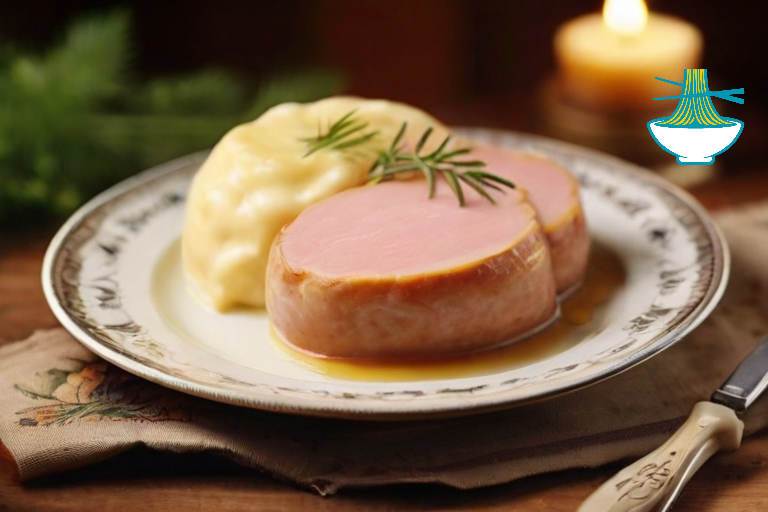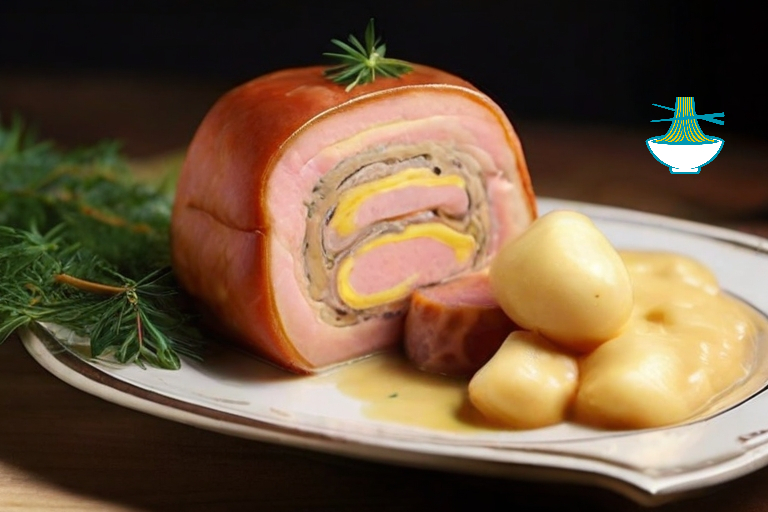Austrian Leberkäse, a traditional savory meatloaf, combines finely ground pork, beef, and bacon, creating a flavorful dish that has been cherished for centuries. The meat used in Leberkäse is rich in essential vitamins like B12, which supports nerve function and energy production, and B6, vital for brain health. It also provides iron, crucial for oxygen transport in the body, and zinc, which boosts the immune system. Additionally, the dish contains antioxidants from the herbs and spices often used in its preparation, offering protection against oxidative stress. While a nutrient-dense option, it’s best enjoyed in moderation due to its high fat and sodium content.

Ingredients:
- 500g pork shoulder, finely ground
- 500g beef chuck, finely ground
- 200g bacon, finely chopped
- 150g ice-cold water
- 2 teaspoons salt
- 1 teaspoon white pepper
- 1 teaspoon marjoram
- 1 teaspoon garlic powder
- 1/2 teaspoon caraway seeds (optional)
- 1/2 teaspoon ground ginger
- 1/4 teaspoon nutmeg
- 1/4 teaspoon allspice
- 1/4 teaspoon coriander (optional)
- 2 tablespoons vegetable oil (for greasing the loaf pan)
Ingredient Substitutions
- Replace meat with plant-based ground alternatives like tofu or seitan, and use plant-based bacon substitutes.
- Opt for leaner cuts of pork or beef, and replace bacon with turkey bacon.
Instructions:
1- Preheat the Oven: Preheat your oven to 180°C (356°F).
2- Prepare Meat Mixture: In a large mixing bowl, combine the ground pork, ground beef, chopped bacon, salt, white pepper, marjoram, garlic powder, caraway seeds (if using), ground ginger, nutmeg, allspice, and coriander (if using). Mix well until all the ingredients are evenly incorporated.
3- Add Ice-Cold Water: Gradually add the ice-cold water to the meat mixture while continuing to mix. This helps to keep the Leberkäse moist.
4- Grease Loaf Pan: Grease a loaf pan with vegetable oil to prevent sticking.
5- Form the Loaf: Transfer the meat mixture into the greased loaf pan, pressing it down to form a uniform loaf shape.
6- Bake: Place the loaf pan in the preheated oven and bake for approximately 1 to 1.5 hours or until the Leberkäse has a golden-brown crust on top and is cooked through.
7- Cool and Slice: Allow the Leberkäse to cool for a few minutes before removing it from the pan. Once cooled, slice it into thick slices.
8- Serve: Austrian Leberkäse can be served warm or cold. Enjoy it as a main dish with mustard or in sandwiches.
Feel free to adjust the spices and seasonings according to your taste preferences. This recipe captures the essence of traditional Austrian Leberkäse, providing a delicious homemade version of this classic dish.
Serving Suggestions
- Classic Option: Thick slices served warm with mustard or horseradish sauce.
- As a Sandwich: Place slices in a crusty roll or sourdough bread with pickles and fresh greens.
- With Sides: Pair with potato salad, sauerkraut, or a fresh green salad for a complete meal.
Note:High Fat and Sodium Due to the bacon and seasoning, Leberkäse can be high in fat and sodium. Consume in moderation, especially if managing heart health or hypertension.
Frequently Asked Questions
1.What is the origin of the name "Leberkäse"?
- The name comes from the German words "Leber" (liver) and "Käse" (cheese), though the dish traditionally contains neither liver nor cheese. It refers to its texture and loaf shape.
2.Can Leberkäse be made without meat?
- Yes, plant-based alternatives like tofu or ground soy can be used, with the addition of similar spices for flavor.
3.What are the best storage methods for Leberkäse?
- Store in an airtight container in the refrigerator for 3-4 days. For longer storage, freeze the loaf in slices, separated by parchment paper.
4.Is Leberkäse suitable for children?
- It can be made child-friendly by reducing the amount of salt and spices to suit their taste preferences.
5.How can I make Leberkäse less fatty?
- Use leaner meats, reduce or omit bacon, and bake instead of frying.
6.What are good spice substitutes if the original spices are unavailable?
- Common spices like black pepper, cumin, or paprika can work as substitutes while maintaining a similar flavor profile.
Nutritional Values:
Here are approximate nutritional values for the listed ingredients. Keep in mind that these values are general estimates and can vary based on specific brands and preparation methods:
1. 500g pork shoulder, finely ground:
- Calories: 1100 kcal
- Protein: 100g
- Fat: 75g
- Carbohydrates: 0g
Benefits:
- Rich in protein, essential for muscle growth and repair.
- Contains vitamins and minerals, including B vitamins and zinc.
2. 500g beef chuck, finely ground:
- Calories: 1100 kcal
- Protein: 100g
- Fat: 75g
- Carbohydrates: 0g
Benefits:
- High-quality protein source.
- Good source of iron, essential for oxygen transport in the body.
3. 200g bacon, finely chopped:
- Calories: 900 kcal
- Protein: 24g
- Fat: 88g
- Carbohydrates: 0g
Benefits:
- Adds flavor and richness to the Leberkäse.
- Provides protein and healthy fats.
4. 150g ice-cold water:
- Calories: 0 kcal
- Protein: 0g
- Fat: 0g
- Carbohydrates: 0g
Benefits:
- Maintains the moisture content in the meat mixture during cooking.

5. 2 teaspoons salt:
- Calories: 0 kcal
- Protein: 0g
- Fat: 0g
- Carbohydrates: 0g
Benefits:
- Enhances flavor.
- Important for electrolyte balance and nerve function.
6. 1 teaspoon white pepper:
- Calories: 6 kcal
- Protein: 0.3g
- Fat: 0.1g
- Carbohydrates: 1.5g
Benefits:
- Adds a mild heat and flavor.
- May have antioxidant properties.
7. 1 teaspoon marjoram:
- Calories: 3 kcal
- Protein: 0.2g
- Fat: 0.1g
- Carbohydrates: 0.6g
Benefits:
- Contributes a pleasant herbaceous flavor.
- Contains vitamins A and C.
8. 1 teaspoon garlic powder:
- Calories: 10 kcal
- Protein: 0.5g
- Fat: 0g
- Carbohydrates: 2.3g
Benefits:
- Adds a distinctive savory taste.
- Known for potential health benefits, including immune system support.
9. 1/2 teaspoon caraway seeds (optional):
- Calories: 4 kcal
- Protein: 0.2g
- Fat: 0.2g
- Carbohydrates: 0.8g
Benefits:
- Imparts a unique and aromatic flavor.
- May aid digestion.
10. 1/2 teaspoon ground ginger:
- Calories: 3 kcal
- Protein: 0.1g
- Fat: 0g
- Carbohydrates: 0.7g
Benefits:
- Adds warmth and depth to the flavor.
- May have anti-inflammatory properties.
11. 1/4 teaspoon nutmeg:
- Calories: 3 kcal
- Protein: 0g
- Fat: 0.2g
- Carbohydrates: 0.3g
Benefits:
- Enhances the overall spice profile.
- Contains antioxidants.
12. 1/4 teaspoon allspice:
- Calories: 2 kcal
- Protein: 0.1g
- Fat: 0g
- Carbohydrates: 0.4g
Benefits:
- Contributes to the warm and aromatic flavor.
- Contains essential oils with potential health benefits.
13. 1/4 teaspoon coriander (optional):
- Calories: 2 kcal
- Protein: 0.1g
- Fat: 0.1g
- Carbohydrates: 0.4g
Benefits:
- Adds a citrusy and slightly sweet note.
- Contains antioxidants and may have digestive benefits.
14. 2 tablespoons vegetable oil (for greasing the loaf pan):
- Calories: 240 kcal
- Protein: 0g
- Fat: 28g
- Carbohydrates: 0g
Benefits:
- Prevents sticking during baking.
- Provides healthy fats and energy.
These values are based on standard nutritional information for the individual ingredients. Keep in mind that the total nutritional content of the Leberkäse will depend on the serving size and the specific cooking process.


Comments